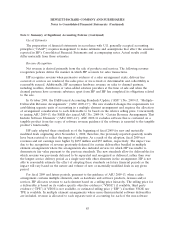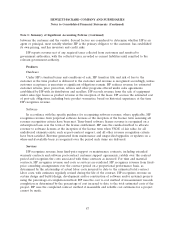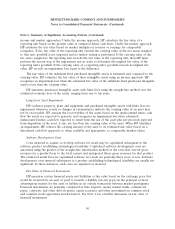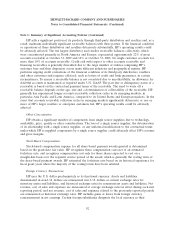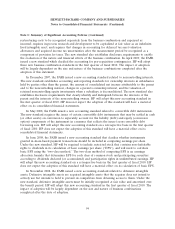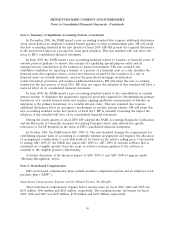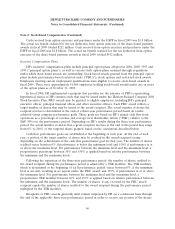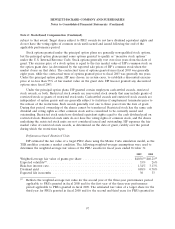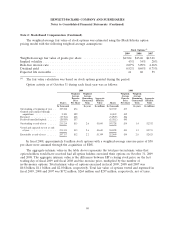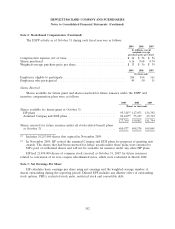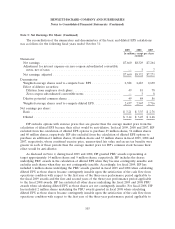HP 2009 Annual Report Download - page 101
Download and view the complete annual report
Please find page 101 of the 2009 HP annual report below. You can navigate through the pages in the report by either clicking on the pages listed below, or by using the keyword search tool below to find specific information within the annual report.HEWLETT-PACKARD COMPANY AND SUBSIDIARIES
Notes to Consolidated Financial Statements (Continued)
Note 1: Summary of Significant Accounting Policies (Continued)
restructuring costs to be recognized separately from the business combination and expensed as
incurred; requires in-process research and development to be capitalized at fair value as an indefinite-
lived intangible asset; and requires that changes in accounting for deferred tax asset valuation
allowances and acquired income tax uncertainties after the measurement period be recognized as a
component of provision for taxes. The new standard also establishes disclosure requirements to enable
the evaluation of the nature and financial effects of the business combination. In April 2009, the FASB
issued a new standard which clarified the accounting for pre-acquisition contingencies. HP will adopt
these new business combination standards in the first quarter of fiscal 2010. The impact of adoption
will be largely dependent on the size and nature of the business combinations completed after the
adoption of this statement.
In December 2007, the FASB issued a new accounting standard related to noncontrolling interests.
The new standard establishes accounting and reporting standards for ownership interests in subsidiaries
held by parties other than the parent, the amount of consolidated net income attributable to the parent
and to the noncontrolling interest, changes in a parent’s ownership interest, and the valuation of
retained noncontrolling equity investments when a subsidiary is deconsolidated. The new standard also
establishes disclosure requirements that clearly identify and distinguish between the interests of the
parent and the interests of the noncontrolling owners. HP will adopt this new accounting standard in
the first quarter of fiscal 2010. HP does not expect the adoption of this standard will have a material
effect on its consolidated financial statements.
In May 2008, the FASB issued a new accounting standard related to convertible debt instruments.
The new standard requires the issuer of certain convertible debt instruments that may be settled in cash
(or other assets) on conversion to separately account for the liability (debt) and equity (conversion
option) components of the instrument in a manner that reflects the issuer’s non-convertible debt
borrowing rate. HP will adopt this new accounting standard on a retrospective basis in the first quarter
of fiscal 2010. HP does not expect the adoption of this standard will have a material effect on its
consolidated financial statements.
In June 2008, the FASB issued a new accounting standard that clarifies whether instruments
granted in share-based payment transactions should be included in computing earnings per share.
Under the new standard, HP will be required to include restricted stock that contains non-forfeitable
rights to dividends in its calculation of basic earnings per share (‘‘EPS’’), and will need to calculate
basic EPS using the ‘‘two-class method.’’ The two-class method of computing EPS is an earnings
allocation formula that determines EPS for each class of common stock and participating securities
according to dividends declared (or accumulated) and participation rights in undistributed earnings. HP
will adopt this new accounting standard on a retrospective basis in the first quarter of fiscal 2010. HP
does not expect the adoption of this standard will have a material effect on its calculation of basic EPS.
In November 2008, the FASB issued a new accounting standard related to defensive intangible
assets. Defensive intangible assets are acquired intangible assets that the acquirer does not intend to
actively use but intends to hold to prevent its competitors from obtaining access to them. Under the
new standard, defensive intangible assets must be initially recognized at fair value and amortized over
the benefit period. HP will adopt this new accounting standard in the first quarter of fiscal 2010. The
impact of adoption will be largely dependent on the size and nature of business combinations
completed after the date of adoption.
94



